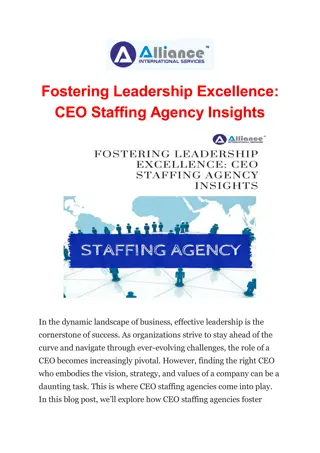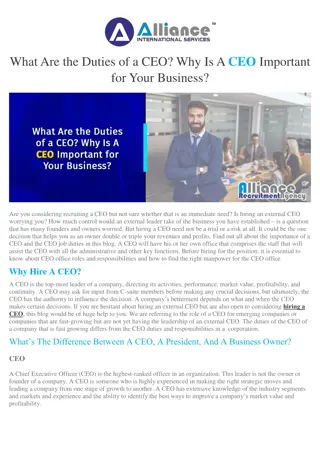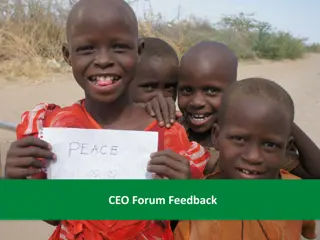Sharpening the Strategic Planning Process: CEO Forum Discussion
The CEO Forum is set to discuss key aspects of the strategic planning process, aligning on success measures, strategic plan type, non-negotiables, and governance. The focus is on clarifying expectations and enhancing the effectiveness of the plan. Success measures, plan type considerations, and the recommendation for an outcomes-focused plan are highlighted for stakeholder consideration.
Download Presentation

Please find below an Image/Link to download the presentation.
The content on the website is provided AS IS for your information and personal use only. It may not be sold, licensed, or shared on other websites without obtaining consent from the author.If you encounter any issues during the download, it is possible that the publisher has removed the file from their server.
You are allowed to download the files provided on this website for personal or commercial use, subject to the condition that they are used lawfully. All files are the property of their respective owners.
The content on the website is provided AS IS for your information and personal use only. It may not be sold, licensed, or shared on other websites without obtaining consent from the author.
E N D
Presentation Transcript
Sharpening the Process For discussion by the CEO FORUM Wednesday, July 31st
Purpose and Agenda Purpose To clarify/confirm key aspects of the strategic planning process to ensure shared expectations among all involved. Decisions will also help to inform deliverable guidance provided to working groups in early August by the Strategic Integration Team (SIT). Process and Agenda Review and decide on proposals in four areas: Success Measures: What are the specific success measures that will be used to evaluate the effectiveness of the process and plan? (see p. 3) Plan type: What type of strategic plan will best serve the Alliance? (see p. 4 - 5) Givens : What will not change/is not up for debate in this process? (see p. 6) Governance: Decision-Makers and Decision Criteria (see p. 7 8) 2
Success Measures High-level criteria that help everyone understand what a successful process and end product look like. Limited in number reflect must haves rather than nice to haves . Will be used as design criteria to further sharpen the process. In May, the CEO Forum identified three success measures for the strategic plan and planning process. The original success measures are in black, suggested clarifications are provided in red. Do you support these success measures? 1. The Alliance has a (one) clear goal for the change (impact) we want to achieve for children. 2. The Alliance identity is simple (straightforward, easy to understand) and a source of pride (around the vision that unites us). 3. Ownership at all levels especially local staff. The plan will be relevant to the diverse realities of Alliance members. The plan process will include perspectives of local office staff. 4. The Plan adds value/strengthens the sustainability of members. 3
Strategic Plan Requirements - Type Clarifies the nature of the desired end product the plan for internal use, Strategic plans often fall on a spectrum from outcome-focused to activity-focused. The type of plan chosen relates to both organizational ambitions and its capability to manage the plan. OUTCOMES ACTIVITIES See examples on following slide Activity Focused (Five-Year Plan) Sets organizational accountability at the activity level (means). Emphasizes what will be done assumes long-term plans are critical for decision- making. Requires the ability to centrally measure activity completion. May be supplemented by measurement via other means, e.g., organizational KPIs. Outcomes Focused (Strategic framework) Sets organizational accountability at the outcome level (ends). Assumes long-term action plans cannot be feasibly developed centrally, or plans are quickly outdated Requires short-term planning throughout implementation, as well as the ability to measure and monitor outcomes The SIT recommends an outcomes-focused plan because: This is a build strategy we have sufficient knowledge to identify the measurable impact we wish to have in key areas. This type is more appropriate for the Alliance, which aims to create a plan that is owned and contributed to by all members. Note: This will require us to develop the means to measure and monitor progress against outcomes. Do you agree that we should aim to create an outcomes-focused plan? (Additional discussions will be necessary to develop the detailed format of the plan. We are aiming here for a directional decision.) 4
Examples Outcomes Focused Activity Focused 5
Givens Clarify areas that are not anticipated to change as a result of this process, or have already been decided and should not be subject to additional debate as part of the process. Resource constraints help to developed shared expectations related to plan viability. Do any adjustments need to be made to the list of givens? Programmatic Our primary programmatic focus is on Ending Violence Against Children. We will continue to support SDG 16.2. Existing emergency response efforts will be maintained. Operational The plan will primarily be resourced by allocating/redirecting existing resources (human, monetary). Significant additional resources for plan implementation should not be assumed. Organizational This is a build strategy. As such, the process is not designed to create major changes in our Mission, Vision, Values, etc. However, some adjustments could made, if necessary to align with the outcomes of the planning process. 6
Decision-Makers The chart below outlines decision-making authority for key roles in the process. Are any clarifications needed? In particular, it is important to build shared understanding of the SIT s role. The SIT was created to provide the support and guidance necessary to ensure alignment throughout the process. The SIT makes decisions on tactical elements of the process (e.g., due dates, deliverable requirements). It also provides directional input to working groups, and integrates and clarifies outputs of working groups prior to consideration by the CEO Forum. Topic Working Groups SIT CEO Forum Board Plan and Process Success Measures and Decision Criteria Input (at working group level) Recommend Decide Input Process Schedule, Deliverable Guidance Input Decide (and recommend) Agree NA Working Group Process; Meetings; Interim Deliverables; Sub-criteria; Group decision process Decide (and recommend) Agree NA NA NOV Selection of options (to move forward for more detailed planning) Recommend options Agree (with working group recommendations) Decide Input FEB Alignment and Tradeoffs initial plan build out Recommend options Agree ( with working group recommendations) Decide NA MAY - Approval of final plan Recommend options Agree (with working group recommendations) Recommend (to Board) Decide Decide: Makes final decision Agree: Must agree with recommendation (some veto power on recommendations) Recommend: Gathers data, analyzes, provides recommendation with alternatives Input: Provides input to recommendations. 7
Decision Criteria Shared criteria provide clarity and consistency to the decision process; align with overall success measures. Support the holistic evaluation of ideas to ensure plan is both ambitious and feasible. Intended to be used for decision-making at all levels Board, CEO Forum, SIT, Working Group. Do you support using consistent, transparent criteria to inform decisions? Do you agree with decision-criteria as outlined below? Desirability Does this address the right need/opportunity? Will this address a significant need for those we serve (or for the Alliance)? Will it result in demonstrable impact produce significant benefit to those we serve (or for the Alliance)? Is this compelling to beneficiaries, members, or potential partners (institutional, individual)? VIABILITY FUNDING GROWTH DESIRABILITY NEED IMPACT COMPELLING Viability Is this financially sustainable? Can the Alliance realistically fund/support the development and ongoing maintenance of this effort? Will it contribute to financial growth? SWEET SPOT FEASIBILITY ADVOCACY BRAND EXPERTISE Feasibility Does this build on the Alliance s existing operational strengths? Does this leverage or strengthen the Alliance s core competencies (advocacy)? Does this leverage or strengthen the Alliance brand? Does this leverage or strengthen existing technical expertise of a significant number of members?If new expertise, can it be built in 2-3 years? 8























